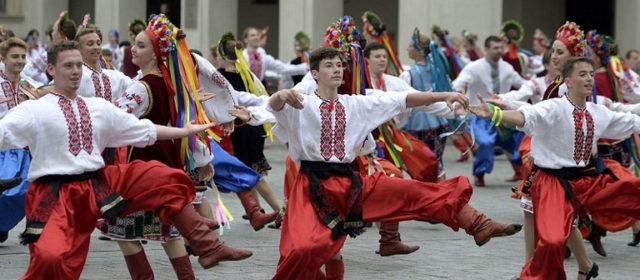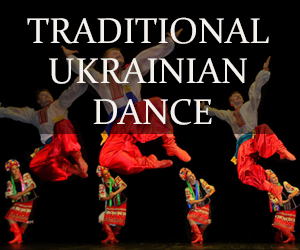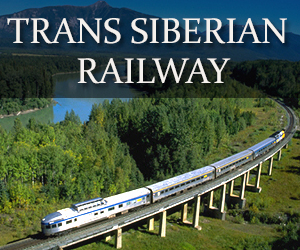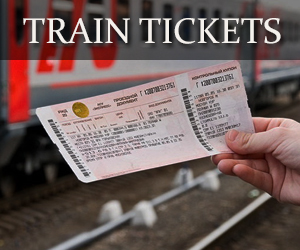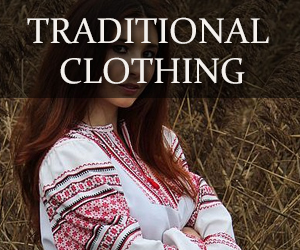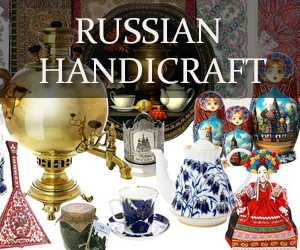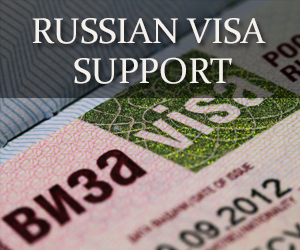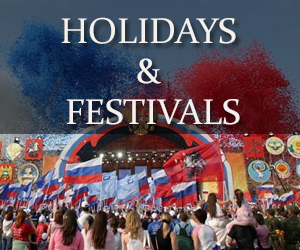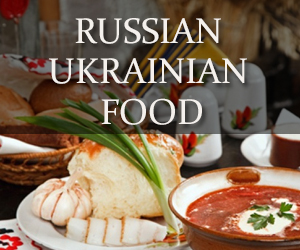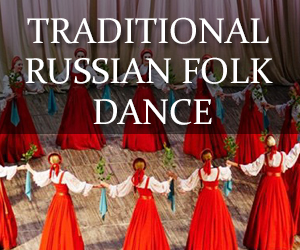Traditional Ukrainian dance is one of Ukraine’s most recognized cultural exports. Known and respected worldwide, audiences are not only entertained with the energetic, often fast paced dance, but by also by elaborate, hand embroidered costume and accompanying folk music.
Today, Ukrainian folk dance is mostly performed as choreographed stage performances, representations of traditional dances that have evolved in all corners of Ukraine over the centuries. The following is a list of the most popular folk dance found in Ukraine.
Folk Dance From Ukraine
Kozachok (Козачок)
Kozachok is a Cossack dance that has its origins in Vertep, a Ukrainian puppet theatre that appeared in the early 17th century. A fast, linear dance in 2/4 time, the woman leads and the man follows – imitating her figures. Danced in an ever increasing tempo, the woman signals movement changes by clapping her hands. Varriants of the Kazachok include the Veretepny Kazachok (Zaporizhian region), the Kuban Kazachok (Krasnodar region of southern Russia), and Ter Kazachok (northern Caucasus region).
Hopak (Гопак)
Often referred to as the National Dance of Ukraine, Hopak is a Cossack dance that has its origins in the early 16th century. Popular with amateur and professional Ukrainian dance ensembles, several composers have also incorporated Hopak into opera and ballet. While not standardized by melody or tempo, a 2/4 time predominates most arrangements, with the pace of the music changing from segment to segment. Such variation evokes a sense of improvisation, allowing dancers to distinguish themselves, and usually culminates with a fast paced, boisterous finale.
Povzunets (Повзунець)
Povzunets (“crawler”) is a another traditional Cossack dance. Performed solely by men, the performer squats, sits or kneels throughout the duration of the dance – beginning to end.
Chumaky (Чумаки)
Chumaky, yet another popular Cossack folk dance, depicts of the lives of Ukrainian merchants and traders known as “Chumaky”. The Chumak merchant, who prospered until the late 19th century, left his mark in national culture, in literature and folklore and in this traditional Ukrainian dance.
Podolian Dance
Poldolian dance originates from Podolia, a historical region located in the west-central and south-west portions of present-day Ukraine (Khmelnitsky and Vinnitsa Oblasts), as well as the northern Transnistria region of Moldova. The dance may have particular significance to Canadians with Ukrainian heritage as it was this region (at the time Austrian Podolia) that witnessed a large scale emigration of its peasant population to western Canada.
Hutsulka (Гуцулка)
The Hutsulka is a traditional dance of the Hutsul, an ethno-cultural group of Ukrainians who inhabitant the highlands of the northeastern Carpathian Mountains. A well-known Ukrainian dance (only second to Cossack dances above), Hutsulka is recognized for being lively and energetic, characterized by quick stomping and intricate footwork.
Kolomeyka (Коломийка)
Kolomeyka is another Hutsul Dance. Originating from the Pokuttia region along the Ukrainian, Polish, Romanian border, the dance was, in essence, named after the city of Kolomyia, the largest city in the region.
Bereznyanka (Березнянка)
Bereznyanka is a traditional dance of Zakarpattia Ukrainians (far west tip of Ukraine that is located in the Carpathian Mountains). Dances from the region, including the Bereznyanka, are known for their large and sweeping movements, and are generally “bouncy”.
Bukovynian Dance
Dance originating from the Bukovyna region of Ukraine and Romania (a region of both highlands and adjoining plains of the northeastern Carpathian Mountains), is a dichotomy of different themes and foot work. Perhaps a reflection of such a varied dance, the region itself has been at one time or another Romanian, Ukrainian, Austrian and Tatar. Each era has no doubt left it’s influence on the local culture and dance.
Volyn Dance
Dance originating from the Volyn region of Ukraine (a region of northwestern Ukraine), has been heavily influenced by Polish culture and dance. The dance is characterized by energetic jumping, leg kicks and animated arms, all typical of Polish dance.
Polesian Dance
Dance originating from the region of Polesia (a swampy lowland region of northern Ukraine, southern Belarus), is characterized by bouncy movements and high knee movements. White and red typifies traditional costume and girls commonly wear an embroidered apron.
Lemko Dance
One of the more interesting cultures of the Carpathian Mountain region is the Lemko ethnic group (also known as Rusyns). Isolated from ethnic Ukrainian culture, it is debated whether their native Rusyn (Ruthenian) language is a separate Eastern Slavic language (along with Russian, Belarusian, and Ukrainian), or simply a dialect of Ukrainian. Traditional territory of the Lemko peoples includes the Transcarpathian region of Ukraine, northeastern Slovakia, and southeastern Poland. Today, following their 1946 deportation from native Ukrainian and Polish homelands, the only remaining population of Lemkos is in the Prešov region of Slovakia. It his here where you can still enjoy their light-hearted and lively dance.
Boiko Dance
Dance originating from a distinctive group of Ukrainian Carpathian highlanders known as Boiko. The Boiko territory traditionally fell in the mountainous regions of Ivano-Frankivsk and Lviv Oblasts, small pieces of the Zakarpattia Oblast, as well as the adjacent areas of southeast Poland and northeast Slovakia. Like the Lemko, the Boiko have their historical roots in Rusyn (Ruthenian) language and culture and as such shares similarities, both in costume and movement, to that of Lemko dance (see above).
Crimean Tatar Dance
Although the Crimean Tatar population has been decimated over the centuries (learn more), remnants of the Tatar population on Ukraine’s Black Sea peninsula have managed to preserve pieces of their culture and tradition. Dance is one such tradition the Crimean Tatar still practice at weddings, ceremonies and celebrations.
Gypsy Dance
The Roma people (or Tsiganki as they are known in Eastern Europe), have long been a part of the greater Ukrainian culture. They have found their way into folklore, superstition and even dance. Today, many national dance ensembles now incorporate Gypsy dance into their repertoire along with more traditional Ukrainian dance routines.

